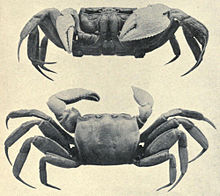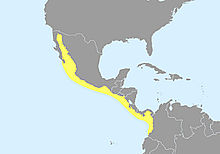Hoplocypode
| Gulf ghost crab | |
|---|---|
 |
|
| Hoplocypode occidentalis male | |
| Scientific classification | |
| Kingdom: | Animalia |
| Phylum: | Arthropoda |
| Subphylum: | Crustacea |
| Class: | Malacostraca |
| Order: | Decapoda |
| Infraorder: | Brachyura |
| Family: | Ocypodidae |
| Subfamily: | Ocypodinae |
| Genus: |
Hoplocypode Sakai & Türkay, 2013 |
| Species: | H. occidentalis |
| Binomial name | |
|
Hoplocypode occidentalis (Stimpson, 1860) |
|
 |
|
| Gulf ghost crab distribution range (in yellow) | |
| Synonyms | |
|
|
The gulf ghost crab, Hoplocypode occidentalis, is a species of ghost crabs native to the Pacific coast of the Americas, from the Gulf of California to Colombia. It is the only species in the genus Hoplocypode. Gulf ghost crabs are medium-sized, reaching a maximum overall body diameter of 6 in (15 cm). They are one of only two ghost crab species found in the eastern Pacific (the other being the painted ghost crabs). However, gulf ghost crabs can easily be distinguished from painted ghost crabs by the absence of "horns" on their eyes.
Hoplocypode occidentalis was first described by the American marine biologist William Stimpson in 1860 as Ocypoda occidentalis. The type specimens were originally collected from Cabo San Lucas, Baja California, Mexico. It was transferred to its own genus Hoplocypode in 2013 by Katsushi Sakai and Michael Türkay based on the differences of their gonopods (appendages modified into copulatory organs) from that of the rest of the members of the genus Ocypode. It is classified under the ghost crab subfamily Ocypodinae in the family Ocypodidae.
The generic name Hoplocypode is derived from Ancient Greek (hoplē, "hoof") and ocypode, referring to the hoof-shaped tip of the first gonopod of males. The latter is derived from the Ancient Greek ocy- ("swift" or "fast") and (podos, "foot"), in reference to the animal's speed. The specific name is from Latin ("western"). They are commonly known as the "gulf ghost crab" in English and cangrejo de playa in Spanish.
...
Wikipedia
